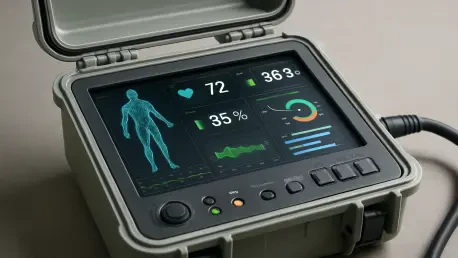The Health and Usage Monitoring System (HUMS) market is poised for a remarkable evolution, set to redefine the intersection of healthcare and technology in the coming years. With a current valuation of $2.48 million as of last year, this dynamic sector is projected to expand dramatically to $5 billion by 2035, driven by a consistent compound annual growth rate (CAGR) of 6.6% over the next decade. HUMS encompasses an array of innovative tools such as wearable devices, remote patient monitoring systems, and AI-powered analytics platforms that capture real-time health and usage data. This growth trajectory highlights a global shift toward proactive, data-centric healthcare solutions that address critical challenges like chronic disease management and rising medical costs. By bridging traditional healthcare with cutting-edge digital advancements, HUMS is emerging as a vital component in modern wellness and medical practices, promising to enhance patient outcomes and system efficiency on a massive scale.
Understanding the Core of HUMS and Its Relevance
The HUMS market represents a pivotal segment of the healthcare technology landscape, focusing on systems that enable continuous health monitoring and data-driven care. Starting from a base value of $2.48 million in 2024, the market is expected to see an incremental rise to $2.64 million this year, setting the stage for its long-term ascent to $5 billion by 2035. Technologies within this domain, including smartwatches, fitness trackers, and remote monitoring tools, provide both patients and healthcare professionals with critical insights into health metrics. This capability is transforming how care is delivered, moving from reactive treatments to preventive strategies. The relevance of HUMS is underscored by its role in managing a variety of health concerns, particularly in an era where immediate access to health data can make a significant difference in outcomes. As digital health adoption accelerates, the market’s importance becomes even more pronounced, positioning it as a cornerstone of future medical ecosystems.
Beyond its technological offerings, HUMS addresses systemic issues plaguing global healthcare, such as overburdened facilities and the high cost of in-person care. By enabling remote monitoring and home-based interventions, these systems alleviate pressure on traditional medical infrastructures, allowing for more efficient resource allocation. This is particularly crucial for aging populations and individuals with chronic conditions who require consistent oversight without frequent hospital visits. Moreover, the integration of cloud-based platforms ensures that data is accessible across various care settings, enhancing coordination among providers. The market’s ability to adapt to diverse needs—from individual wellness tracking to comprehensive patient management—demonstrates its versatility and growing indispensability. As healthcare continues to digitize, HUMS stands out as a solution that not only meets current demands but also anticipates future challenges, driving a paradigm shift in how health is monitored and maintained.
Forces Propelling Market Expansion
Several intertwined factors are fueling the HUMS market’s projected growth to $5 billion by 2035, reflecting both societal needs and technological progress. A primary driver is the escalating prevalence of chronic diseases such as diabetes and heart conditions, coupled with a steadily aging global population. These demographic trends necessitate ongoing health surveillance, which HUMS technologies address through wearable sensors and remote monitoring capabilities. Such tools enable early detection and timely interventions, reducing the risk of severe complications and improving quality of life for millions. This demand is evident across both developed and emerging economies, where healthcare systems are increasingly seeking sustainable ways to manage long-term health challenges. The urgency to adopt these solutions is shaping investment and innovation in the sector, ensuring that HUMS remains at the forefront of addressing critical public health issues.
Another significant force behind this growth is the broader transition to data-driven healthcare models. Medical institutions and providers are harnessing the power of analytics and real-time usage data to refine patient care strategies and optimize operational efficiencies. This shift is supported by rapid advancements in complementary technologies like artificial intelligence, the Internet of Things (IoT), and cloud computing, which enhance the precision and accessibility of HUMS solutions. Features such as predictive analytics allow for the anticipation of health events before they occur, while seamless data integration ensures that insights are actionable across platforms. Additionally, economic pressures within healthcare systems, including rising costs and high patient volumes, amplify the need for remote care options that HUMS facilitates. By reducing dependency on physical consultations, these systems offer cost savings for providers and patients alike, solidifying their role as a transformative force in the industry.
Trends Redefining the HUMS Landscape
The HUMS market is undergoing a profound transformation, shaped by innovative trends that cater to evolving consumer and clinical needs. Wearable devices stand out as a dominant force, with their segment valued at $800 million in 2024 and projected to climb to $1.5 billion by 2035. Products like smartwatches and fitness bands have gained widespread popularity for tracking vital signs such as heart rate and activity levels, empowering individuals to take charge of their personal health. This trend reflects a cultural shift toward self-managed wellness, where consumers prioritize tools that integrate seamlessly into daily routines. The appeal of wearables extends beyond fitness enthusiasts to those managing chronic conditions, highlighting their broad applicability. As technology continues to miniaturize and improve, these devices are becoming more sophisticated, offering deeper insights and fostering greater engagement with health management.
Equally impactful is the rise of remote patient monitoring (RPM), propelled by the expansion of telehealth and home-based care frameworks. RPM systems enable healthcare providers to oversee patients’ conditions outside clinical environments, ensuring compliance and enabling swift responses to anomalies. This is particularly vital for aging demographics and those with long-term illnesses, where constant monitoring can prevent emergencies. Technological integrations, such as AI-driven analytics and IoT connectivity, further elevate HUMS capabilities by providing predictive alerts and real-time data sharing. Regionally, North America leads with a market value of $1.05 billion in 2024, expected to grow to $1.95 billion by 2035, thanks to robust infrastructure and regulatory support. Meanwhile, regions like Asia-Pacific are catching up, driven by increased healthcare spending and digital initiatives. These trends collectively illustrate a market that is not only adapting to current demands but also paving the way for a more connected and responsive healthcare future.
Opportunities and Future Horizons
The HUMS market offers a wealth of opportunities for stakeholders aiming to leverage its projected growth to $5 billion by 2035. One promising area is the development of personalized health solutions that cater to individual needs and preferences. As consumers demand greater control over their health data, there is a rising appetite for customized monitoring tools that deliver tailored recommendations. Companies that prioritize user-centric design and actionable insights stand to gain a competitive advantage in this space. Additionally, emerging markets in regions like Asia-Pacific, Latin America, and the Middle East present untapped potential, fueled by improving digital infrastructure and supportive policies. These areas offer fertile ground for expansion, particularly for firms willing to adapt solutions to local contexts. Capitalizing on these opportunities requires a focus on accessibility and cultural relevance to ensure widespread adoption.
Another key avenue lies in the integration of HUMS with adjacent sectors such as insurance and wellness programs. Insurers are increasingly utilizing health and usage data to refine risk assessments and personalize premiums, while wellness brands use these systems to encourage healthier lifestyles. This synergy fosters innovation and broadens the market’s reach, creating ecosystems where health technology intersects with everyday life. Furthermore, strategic partnerships in technology—spanning AI, cloud platforms, and IoT—can drive the creation of cutting-edge solutions like real-time alerts and interoperable data systems. Addressing challenges such as data privacy and regulatory compliance will be critical to building trust and accelerating uptake. As the market evolves, stakeholders who invest in secure, scalable, and collaborative approaches will likely shape its trajectory, ensuring that HUMS continues to meet the diverse needs of a global population.
Strategic Insights for Sustained Growth
Looking toward 2035, the HUMS market’s projected valuation of $5 billion reflects a stable and promising growth path with a 6.6% CAGR. This consistent expansion suggests the maturation of key segments like wearables and remote monitoring, which are becoming integral to both clinical and consumer applications. North America is anticipated to retain its dominance, supported by advanced technological adoption and healthcare frameworks. However, accelerated growth in Europe and Asia-Pacific indicates a more balanced global distribution of market influence over the next decade. The broadening scope of HUMS—extending into fitness, home care, and insurance models—points to an increasingly interconnected health ecosystem. Stakeholders who emphasize interoperability and user trust through robust data security measures will be well-positioned to lead this transformation, ensuring that innovations align with practical needs.
Beyond current projections, the future of HUMS hinges on navigating complex challenges such as regulatory landscapes and user adoption rates. As these systems become embedded in daily life, ensuring accessibility across diverse demographics will be paramount. Collaboration among technology providers, healthcare entities, and policymakers will likely define the next phase of growth, fostering environments that encourage innovation while safeguarding privacy. The market’s evolution will also depend on the ability to translate vast amounts of health data into meaningful outcomes, prioritizing analytics that drive actionable results. By focusing on these strategic areas, the industry can sustain its upward trajectory, ultimately contributing to a healthcare landscape that is more proactive, personalized, and efficient. This forward-looking perspective underscores the potential for HUMS to not only grow in value but also in impact, reshaping how health is understood and managed worldwide.









